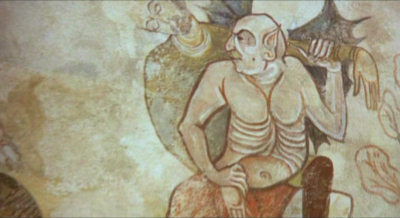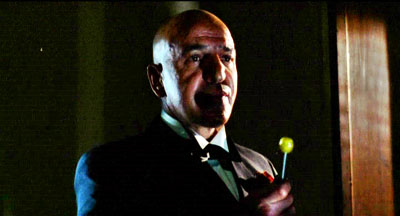|
These two films are actually the same film. Sort of. Lisa and the Devil is a stylish if often incomprehensible Italian genre film which was shot in the fall of 1972 by Mario Bava, one of the masters of Gorotica. It came and went in Europe without any spectacular success, but the producer Alfredo Leone (aka Mickey Lion) had an idea to make the film more profitable in the lucrative North American market. At about the same time that Lisa and The Devil hit the screens in Italy, The Exorcist was becoming a box office phenomenon in the States. The States were possessed with possession, and Leone hoped to cash in on the craze. Why not? He figured that he already owned a movie about the devil, so why not re-jig it and add some spinning heads, cursing, vomiting, and a priest tortured by his own regrets. Although ol' Mickey Lion had never written or directed a movie before, and would never do so again, he decided to take some footage from Lisa and the Devil and shoot about thirty minutes of additional framing story about a woman in need of an exorcism. The new footage took place in the present, and the footage from Lisa and The Devil provided flashback sequences to demonstrate how the demonic possession had occurred. Leone called Elke Sommer back in 1974, recreated her tacky pastel green suit from the first movie, and went about creating his magnum opus. Complete spoilers ahead: The original plot of Lisa and the Devil goes something like this: |
|
|
Lisa (Elke Sommer) is part of a tour group which is
on the final leg of a summer holiday. They are in a public square in
Spain,
admiring some enormous frescoes, as the tour guide natters on about
a particular fresco which pictures the devil carrying off human souls. Lisa's
eyes lock on the image of the devil, and she notices that the dark
lord looks exactly like Kojak (right). Who loves yer soul, baby? After a long summer filled with lectures about frescoes, Lisa is bored with the entire process, so she wanders away from her tour group to explore some quaint alleys on her own. |
|
|
Well, I think we know that can't be good. Those quaint back alleys lead to the inevitable spooky antique and curiosity shop filled with the usual spooky characters. Aladdin is in there checking out the lamp department, and ... hey, there's Satan over by the notions counter. It's well known that Satan can never get enough notions. As it turns out, he's also an avid collector of life-sized ventriloquist dummies, and he's picking one up for himself, although he tells the proprietor it's "for a friend." Lisa realizes that it is probably unwise to pursue her antiquarian interests in the same place where Satan shops. Imagine the prices. Lucifer can obviously afford to pay full retail. She therefore makes her way back into the twisting alleyways and gets lost in an area where there seems to be no sign of human life. As she despairs of ever finding her way back, she sees someone approaching - it's Satan and his mannequin! Although we expect some havoc to be wreaked, Satan politely gives her directions back to the square where she left her tour group, and walks off unmenacingly, bidding her a good day. As she heads back to her group, however, she comes upon another man, and he stares at her uncomfortably. She takes a good look at him and ... it's Satan's mannequin come to life! The elderly Pinocchio professes to know Lisa, but insists on calling her Helena. She runs off and ... accepts a ride from a passing rich couple, and they all end up in a spooky mansion with a blind woman and her insane son. |
|
|
It turns out that the castle's inhabitants partake in unspeakable rites,
which is good for me, since I won't have to speak of them. (They are
also untypeable.) Suffice it to say that there are plenty of
corpses, mannequins, ghosts, necrophilia, and insane relatives
locked in their rooms. Most interesting is their
white-gloved and tuxedoed butler who is, of course, none other than Satan/Kojak
again.
This time, Kojak is actually sucking on one of his trademark lollipops (right), presumably because Satan is trying to quit smoking. Geez! You'd think Satan would actually want to increase his smoking. I figured he'd be an eight pack a day guy. I do know this: if Satan wants to quit and is having trouble, that's a bad sign for human smokers. |
|
|
At any rate, the film ends by falling back on the
oldest trick in the book - it turns out that Lisa has actually been in the square with
her tour group the entire time, and the entire plot happened in her
mind while she was staring at the fresco of Kojak/Satan. She even
imagined the lollipop! But wait! As Lisa flies back home with her tour group ... it seems that she has gone beyond reality to the Twilight Zone after all. She falls asleep and when she awakens the plane seems deserted. She moves toward the front and sees all the crazy aristocrats she met at the mansion. She flees to the cockpit and finds Satan flying the plane! Mua-ha-ha-ha! The House of Exorcism goes like this: The new footage takes place after Lisa is found in the public square with her tour group, obviously having been possessed by Satan. She is taken to a hospital where doctors and a priest co-operate in her treatment. The original footage provides the flashbacks used to tell the story as the priest digs it out of her. The priest tries to exorcise Satan from the woman's body, but Satan foils him by taking the form of the priest's naked ex-girlfriend. Unable to defeat Satan in a one-on-one conversation (Satan is the Michael Jordan of debate), the priest decides to go to the house where the possession took place and cleanse it. He seems to be successful, and the film ends. The Lisa and the Devil version is by far the better of the two movies if you care about the quality of the film, but the House of Exorcism has additional nudity, and the only lower body nudity, all provided by Carmen Silva. Additional comment: Italian directors never shoot sound footage. This always makes it uncomfortable for American actors to act in Italian films because the actors may be performing in a tender nude embrace while workers are busily hammering away, building the next set four feet away. The lack of synchronized sound normally presents no problems for interpersonal dialogue. The actors just record the sound later. In this film, for example, American audiences will recognize Telly Savalas and Robert Alda speaking in their own voices, and I think Elke Sommer did her own English dubbing, while most of the other English voices are dubbed by fluent English speakers. In this case, those three stars would also do the dubbing for their characters in any other languages they speak. It is therefore possible for people in many different countries to watch the same Italian film and recognize stars from their own countries as well as from Rome and Hollywood, even though none of the stars have a common language. (It doesn't really matter which language they speak during the filming, because there is no live sound.) The Italian film producers were the first to realize the significance of the global market, and that they could not capitalize on this immense market by making films exclusively in Italian, so they hired great international stars, dubbed the films in many languages, and were the true pioneers in shipping their wares across the globe. (Clint Eastwood became a superstar in just such pictures.) My girlfriend grew up in the Soviet Union, while I grew up in the USA. In general, we saw none of the same films in our youths - except for the Italians! That dubbing system works fine when people are having one-on-one conversations, but the thing that always strikes me as hilarious in these films is the virtual silence in crowd scenes. Since there was no live sound being recorded in those scenes, and since the extras are all Italian anyway (or in this film, Spanish), the crowd noises have to be recreated in a studio. The actors have to make the sounds of Russian crowds, German crowds, American crowds, etc. It's never the real sound of hundreds of confused, overlapping voices. After all, they aren't going to bring a hundred Russians into a sound studio just to say the Russian equivalent of "yadda, yadda." The crowd noises are usually created by just one or two people making many excited comments like "what is that woman doing?", or "look at her", or "what's going on?" They try to change their voices a bit from comment to comment, but you can generally tell it is the same person making many different comments. The comments can all be heard clearly and distinctly, as if they were spoken by the main actors. It's eerie. Of course, that's OK in a horror movie. |
|


